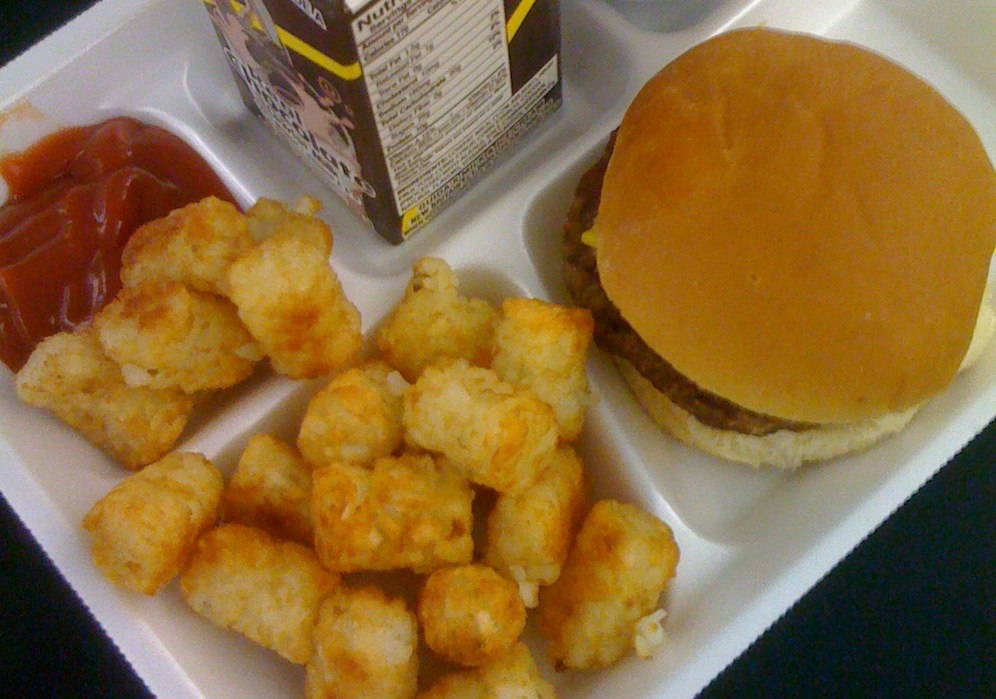
I recently celebrated my one-year anniversary of being a vegetarian. Every second has been worth it, but it has been an exhausting journey. It’s not because I’m dreaming of cheeseburgers and bacon. It’s because of the food at my San Gabriel Valley public high school.
My options are limited: salads, nachos, cheese pizza, or grilled cheese. The salads are dry, the nachos are stale, the pizzas are cold and thin, and the grilled cheese is precooked and wrapped in plastic. I hate to sound like a spoiled teenage brat, but the truth is, they are sad excuses for vegetarian food.
And the rest of what’s served isn’t any better.
So you can see why I stopped eating school lunches after I became vegetarian. When I manage to drag myself out of bed early, I prepare and bring my own lunch. If I’ve hit the snooze button too hard, I get by on a granola bar.
I hardly feel left out. Many of my fellow students—even those who aren’t vegetarian—also have abandoned the idea of eating at school. Why waste a third of your lunch period waiting in line when you could be hanging out with your friends? Why eat pizza that tastes like cardboard if you know it’s going to make you feel sick later?
There are less healthy questions, too. Like: Why wake up early to get to school for breakfast when you could possibly lose some weight by skipping breakfast? I’ve watched female friends tell themselves it’s OK, even good, to lay off lunch. But then it becomes another lunch, and maybe breakfast and dinner, too. Eating disorders are a slippery slope.
And another question: Why bother bringing your own lunch to school when you could sleep for an extra 10 minutes because you’re so exhausted from yesterday’s homework load? In exchange for the promise of future success, my close friends and I have given up our free time, sleep, and often even our lunches. With turning in papers to the office, meeting with our counselors, and stashing sports equipment in our lockers, we are constantly zig-zagging all over campus, frantically trying to get everything done in the 35 minutes our school allots for lunch. Seniors are allowed to leave campus, but they barely have time to get out of the parking lot, find a fast food place, order during the lunch rush, and get back to school.
On top of all this, many of my friends and I are also members of clubs that meet only at lunch. At the busiest times of the school year, I might spend four of my five lunch periods at a club meeting. So when can I possibly eat lunch—much less use the restroom? For a lot of us, our best option is fifth period, the class right after lunch, but some teachers don’t allow eating in their rooms because they are afraid of the mess it might make or the distraction it might cause.
The best solution really is to bring lunch from home. But that means carrying your lunch around all day and finding a place to heat it up (or refrigerate it) if you can. (Thankfully, I am blessed to be a lab assistant for a teacher who has a microwave, refrigerator, toaster oven, and sink.)
All these realities create incentives to skip lunch entirely. I often see students go the whole day with just half a protein bar and an apple slice. Sometimes, students don’t even realize they have skipped meals because they are so busy with assignments and meetings. Other times, it is obvious that their focus level has dropped and they feel exhausted. And for some friends of mine, skipping lunch at school leads to binging at home late at night.
I’m not asking for a five-star caterer to deliver freshly cooked gourmet food to my school every morning. (Though I wouldn’t object to that.) But the way the school handles meals isn’t healthy for students. I also think fighting obesity would be a lot easier if cafeteria options weren’t limited to microwavable, re-heated food.
It pains me to see my fellow students eating unhealthily because they don’t have the time or the ability to do any better.
More money for better lunch options at schools would be money well spent. But at the same time, I think my school should consider creating policies that encourage students to make lunch and healthy eating a priority. I’d also like the administrators and chefs who make the menus to consider students with dietary restrictions. Because even carnivores can agree that nobody should have to eat stale nachos.




Send A Letter To the Editors